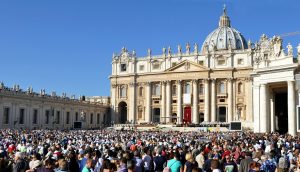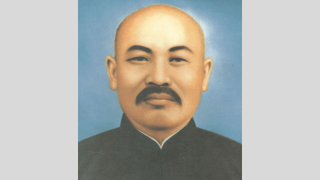Contrary to exaggerated expectations, the Vatican-China agreement has a limited scope—but is described as “the first step in a process”
Massimo Introvigne
On Saturday, September 22, the Vatican announced that it has signed in Beijing a “provisional agreement” with the Chinese government, dealing with the appointment of Catholic bishops in China, whose details remain secret. The international edition of the Chinese official People’s Daily first denied that a Vatican delegation was visiting Beijing, then after the Vatican’s official announcement—mentioning China’s deputy Foreign Minister Wang Chao as the Chinese party who signed it—had to admit that a confidential agreement had been signed. The curious behavior of the Chinese Communist Party (CCP) media confirms that there are opponents of the agreement within the CCP itself.
The Vatican press release reads as follows:
“Today, 22nd September 2018, within the framework of the contacts between the Holy See and the People’s Republic of China that have been underway for some time in order to discuss Church matters of common interest and to promote further understanding, a meeting was held in Beijing between Mgr Antoine Camilleri, Undersecretary for the Holy See’s Relations with States, and H. E. Mr Wang Chao, Deputy Minister for Foreign Affairs of the People’s Republic of China, respectively heads of the Vatican and Chinese delegations.
During that meeting, the two representatives signed a Provisional Agreement on the appointment of Bishops.
The above-mentioned Provisional Agreement, which is the fruit of a gradual and reciprocal rapprochement, has been agreed following a long process of careful negotiation and foresees the possibility of periodic reviews of its application. It concerns the nomination of Bishops, a question of great importance for the life of the Church, and creates the conditions for greater collaboration at the bilateral level.
The shared hope is that this agreement may favour a fruitful and forward-looking process of institutional dialogue and may contribute positively to the life of the Catholic Church in China, to the common good of the Chinese people and to peace in the world.”
Earlier this week, The Wall Street Journal anticipated a much broader agreement, for which, as Bitter Winter reported, the Beijing authorities were not prepared.
What really happened may be summarized as follows:
- The CCP favored in 1957 the birth of a “Patriotic Catholic Church,” with bishops theoretically “elected” by the local Catholics but in fact appointed by the CCP rather than by the Vatican, part of the “red market” of the government-controlled religions in China. The Vatican declared this “Patriotic Church” schismatic and excommunicated its bishops, recognizing in China as truly Catholic only an “underground” Catholic Church, with bishops appointed by the Vatican, which was heavily persecuted by the regime.
- Since the pontificate of Benedict XVI, and in some instances even earlier, the Vatican and the CCP agreed on the appointments of local bishops, which were both selected by the CCP and recognized by the Vatican. The two Catholic Churches, the official and the “Patriotic,” did not merge but in many dioceses had the same bishops.
- This happened in a number of dioceses, while in others the Vatican had strong objections against the bishops selected by the CCP and any agreement proved impossible.
- What happens with the new agreement, although the details are secret, is that the Vatican and the CCP have agreed to solve the existing problems and to establish a (secret) process to identify together the future bishops of all Chinese dioceses. According to a message of the Vatican’s Secretary of State, Cardinal Pietro Parolin, the problems have indeed been solved for all the dioceses where previously there was no agreement, as he announced that “today, for the first time, all the Bishops in China are in communion with the Bishop of Rome,” i.e. with Pope Francis and the Holy See.
- What is not happening, contrary to exaggerated expectations or fears, is the exchange of diplomatic recognitions between the Holy See and China, which would also mean that the Vatican should terminate its diplomatic recognition of Taiwan—the Taiwanese Foreign Ministry rushed to publish a note explaining that this is not the case.
- There is no announcement that the underground and the “Patriotic” churches will merge (which was and is opposed by the top leaders of the Patriotic Church and their supporters in the CCP). Immediately, what we may expect is a gradual extension to all dioceses of the situation already existing in many of them, where the two structures are personally connected by having the same bishop at the top.
- Clearly, in the medium or long term, this process will probably lead to the merging of the two churches, but this requires the negotiation of many further details. Pope Francis’ Vatican has a style of “starting processes” rather than concluding them, and this is yet another example of this strategy.
- Conservative Catholics, including some in China and Hong Kong, are screaming against the “sell-out” of the Catholic Church to CCP. Their position and concerns are understandable. However, with the new law which came into force on February 1, 2018, the alternative for the “underground” Catholic Church was to come to an agreement with the CCP or being wiped out and heavily persecuted. The “underground” Catholic Church is part of a “gray market” of religion President Xi Jinping vowed to eliminate. While most Protestant house churches, also part of the “gray market,” do not have the possibility of coming to similar agreements, the Vatican is both a religious organization and a State. It obviously believes it is in a unique position to find an accommodation that would avoid the persecution and secure a modicum of religious freedom for Catholics in China. The Vatican, after its experience in countries such as Poland or Lithuania, also believes that these agreements offer to it a latitude to operate openly within Communist societies, and subtly influence their transformation from inside. Whether this is a realistic perspective or a dangerous illusion, time will tell. But this is the very reason while sectors of the CCP oppose the agreement and, rather than a global, final, and public treaty with the Vatican, so far what we have is a partial, provisional, and secret one.
Source: Bintter Winter




